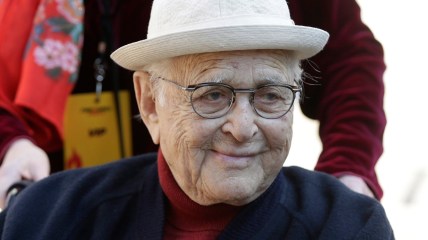Black people, according to Norman Lear
OPINION: While the sitcom producer, who died on Tuesday, is hailed as a revolutionary icon, his legacy is much more complicated when it comes to the Black characters he created.

Editor’s note: The following article is an op-ed, and the views expressed are the author’s own. Read more opinions on theGrio.
Although I was too young to watch most of Norman Lear’s work when it originally aired on primetime network television, I am quite familiar with every episode of the television producer’s Black situation comedies.
Every summer day, at 11 a.m., my sisters and I gathered around the television to watch back-to-back syndicated reruns of “The Jeffersons.” When my cousins visited during our childhood years, they would secretly recount the plot lines from episodes of “Good Times.” Whenever something particularly startling or disquieting happened to my best friend James, he would clutch his chest, stagger in a circle and yell: “It’s the big one! I’m coming for you, Elizabeth!” However, James would never perform his impression of Fred Sanford in front of my mother.
In my house, Norman Lear, who died Tuesday, was contraband.
In all likelihood, my mom probably had no idea that the guy who produced “Good Times” also produced “Sanford and Son.” Because she didn’t have access to the IMDb database, she didn’t applaud Lear for leading a revolution of primetime network sitcoms featuring Black characters. She didn’t care about George and Weezy’s deluxe apartment in the sky or James and Florida’s nuclear family. Aside from her agnosticism on “Diff’rent Strokes,” she hated everything Lear produced. In her mind, Lear produced Blackface caricatures, white people’s versions of Black people.
She had a point.
As far as the American television audience was concerned, “Good Times” is still considered a groundbreaking show that showed an impoverished Black family in the Chicago projects. The main character in “The Jeffersons” was an unapologetic Black man who refused to genuflect to whiteness. “Sanford and Son” was about a single father who ran a Black-owned business … But not really.
Lear’s career reached its zenith in the early 1970s, which coincided with the rise of the Black Power Movement and the resultant consciousness that influenced popular culture and art. In a sense, Lear rode this wave into the entertainment mainstream by creating a progressive but palatable version of entertainment that white people could embrace. It looked Black. It sounded Black. Ultimately, however, these tentpole comedies were written by white people for white people. It was white television.
“Good Times” was not a comedy.
To 10-year-old me, J.J. Evans seemed like a hip teenager with a cool catchphrase. But even when the show was a modest hit, “Good Times” was criticized for sprinkling pimps, drunks, gangbangers and thieves throughout its recurring cast. While the white writers tackled issues like poverty, drug use and even child abuse, Lear’s shows only performatively addressed issues of race. And, even when they did broach the subject, they made sure to highlight the fact that the Black people were also racist. In the Lear Cinematic Universe, anti-Blackness was a not-so-tragic Shakespearean character flaw that made the hero more relatable — like Macbeth’s unbridled ambition or Maude’s depression.
In Lear’s “All In the Family,” Archie Bunker was a cantankerous but lovable lower-middle-class white bigot who occasionally used the n-word. When Lear spun off Bunker’s neighbor George Jefferson, he fashioned George as an upper-middle-class Black loudmouth who was adorable, despite his disdain for interracial relationships and “honkies.” George and Weezy weren’t even real people; they were essentially photo-negative versions of Archie Bunker. When Lear created “Sanford and Son” by adapting the British sitcom “Steptoe and Son,” casting comic genius Redd Foxx in the titular role wasn’t even Lear’s idea. Although I will always contend that Arnold and Willis were kidnapped by a drug dealer named Phillip Drummond, “Diff’rent Strokes” is probably the purest example of white saviorism in television history.
To be clear, none of this is “woke” revisionist history. Esther Rolle, whose character spawned the “Maude” spinoff, said that “Good Times” negative portrayals of Black families were “quietly slipped in … through the character of the oldest child,” causing her to “resent the imagery that says to Black kids that you can make it by standing on the corner saying ‘Dyn-o-mite!’” John Amos eventually left the show for being “too outspoken” on the same issue. Writer Eric Monte settled a $400 million lawsuit that accused Lear, ABC and CBS of stealing his ideas that eventually became “Good Times” and “The Jeffersons.”
In a 1973 review of “Sanford and Son,” columnist Eugenia Collier called the show “white to the core, adding:
But whites (most whites) have so seldom recognized the humanity of black people and have had such a compulsion to rationalize their own inhumanity toward blacks that an honest and compassionate look at black culture has been virtually impossible. For this reason, I am convinced that there are very few—if, indeed, any—white writers who can portray black characters in a realistic and believable manner. I have never ever encountered a believable black character created by a white American mind—and this includes Twain’s Jim, Stowe’s Eliza, Faulkner’s Dilsey, and certainly all the modern characters have seen on stage, screen or television…
Fred Sanford and his little boy Lamont, conceived by white minds and based upon a white value system, are not strong black men capable of achieving—or even understanding—liberation. They are merely two more American child‐men. We—all of us—need to be surrounded by positive—and true— images of blackness based upon black realities, not upon white aberrations.
And none of this is to say that Norman Lear was a racist who hated Black people. He was a television producer who found a niche. He probably thought of himself as progressive. Many people — both Black and white — still do. He was a pioneer who put more Black actors on television screens than any producer in his era. He talked about race and politics and abortion and feminism in a way his predecessors didn’t. And he did it from a perspective of privileged whiteness.
Perhaps Lear’s most enduring legacy is he found a way to tell Black stories without employing Black people as storytellers. He ushered in an era of neo-minstrelsy, with Black bodies shuffling along under a new-millennium spotlight with smiles painted in technicolor Blackface. Yet, because Lear did more than those before him, his work is considered revolutionary. Two things can be true.

Hollywood remembers Norman Lear
A few months ago, I was invited to speak at an event called “A Day of Unreasonable Conversations.” The audience was filled with TV producers and writers, and my panel, “Comedy in Complicated Times,” featured comedians Al Franken, Alex Edelman and Akilah Hughes (I have no idea why I was there, either). A few minutes into the conversation, the panelists began to wax poetic about how Norman Lear kicked in the door for Black television performers. When it was my turn to talk, I deferred to the comedians’ assessment.
“I don’t know that much about Norman Lear,” I said, trying not to disparage a 101-year-old TV icon. “I mostly watched Black shows.”
No one laughed.
My mother would’ve been so proud.

Michael Harriot is an economist, cultural critic and championship-level Spades player. His New York Times bestseller Black AF History: The Unwhitewashed Story of America is available everywhere books are sold.
Never miss a beat: Get our daily stories straight to your inbox with theGrio’s newsletter.

